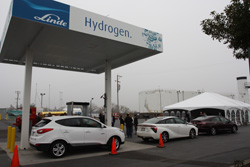LIVERMORE, CALIF. — Sandia National Laboratories and industrial gas giant Linde LLC have signed an umbrella Cooperative Research & Development Agreement (CRADA) that is expected to accelerate the development of low-carbon energy and industrial technologies, beginning with hydrogen and fuel cells.
The CRADA will kick off with two new research and development projects to accelerate the expansion of hydrogen fueling stations to continue to support the market growth of fuel cell electric vehicles now proliferating among the major auto manufacturers. On Nov. 17, Toyota became the latest to unveil a fuel cell electric vehicle.

Last week, Linde opened the first-ever, fully certified commercial hydrogen fueling station near Sacramento with support from the California Energy Commission.
Kickoff projects will help increase H2 fuel station openings
A recent Sandia study, funded by the Department of Energy’s (DOE) Fuel Cell Technologies Office in the Office of Energy Efficiency and Renewable Energy (EERE), determined that 18 percent of fueling station sites in high-priority areas can readily accept hydrogen fueling systems using existing building codes.
The development of meaningful, science-based fire codes and determinations, such as those found in that study, shows that focusing on scientific, risk-informed approaches can reduce uncertainty and help to avoid overly conservative restrictions to commercial hydrogen fuel installations.
Continuing down this path, the first project in the Sandia/Linde CRADA will be demonstrating a hydrogen fuel station that uses a performance-based design approach allowable under the National Fire Protection Association hydrogen technologies code, NFPA 2. The project will include support from the DOE.
California’s Alternative and Renewable Fuel and Vehicle Technology Program states that Linde expects to open new fueling stations in late 2015.
NFPA 2 provides fundamental safeguards for the generation, installation, storage, piping, use and handling of hydrogen in compressed gas or cryogenic (low temperature) liquid form and is referenced by many fire officials in the permitting process for hydrogen fueling stations.
“Sections of NFPA 2 are typically not utilized by station developers, as they instead have focused more on rigid distance requirements for fuel dispensers, air intakes, tanks, storage equipment and other infrastructure,” explained Sandia risk expert and fire protection engineer Chris LaFleur.
“We know we can get hydrogen systems into more existing fueling facilities if our risk analyses show how they meet the code,” she said. “This will help boost the developing fuel-cell electric vehicle market significantly.”
The project, LaFleur added, will provide a foundation for the hydrogen fueling industry to implement the performance-based approach to station design and permitting, leading to sustained expansion of the hydrogen fueling network. The pilot demonstration, she said, will provide clear evidence that a performance-based design is feasible.
Infrastructure, safety the focus of second project
“Linde’s business interests in building and operating more hydrogen fueling stations for retail use align perfectly with our research goals aimed at accelerating clean and efficient energy technologies into the marketplace,” said Chris San Marchi, lead researcher in Sandia’s hydrogen safety, codes and standards program.
“We expect our investment with Sandia will lead to a broader consortium of other commercial partners,” said Nitin Natesan, business development manager at Linde. “We’re happy to lead the way for industry, but ultimately we need others on board to join the effort to address barriers to entry of hydrogen fueling infrastructure.”
The second project currently taking place under the new CRADA focuses on safety aspects of the NFPA code and entails the modeling of a liquid hydrogen release.
“With Linde’s help, we’re developing a science-based approach for updating and improving the separation distances requirements for liquid hydrogen storage at fueling stations,” said LaFleur. Previous work only examined separation distances for gaseous hydrogen, she said, so validation experiments will now be done on the liquid model.
Sandia’s Combustion Research Facility, for years considered a pre-eminent facility for studying hydrogen behavior and its effects on materials and engines, is a key element of the research.
This focus on improving the understanding of liquid hydrogen storage systems, LaFleur said, will result in more meaningful, science-based codes that will ensure the continued expansion of safe and available hydrogen fuel to meet fuel cell electric vehicle demands.
This work is aligned with Hydrogen Fueling Infrastructure Research and Station Technology (H2FIRST), an EERE project established earlier this year, and builds on over a decade of DOE investments in developing meaningful codes and standards to accelerate hydrogen and fuel cell markets in the U.S.